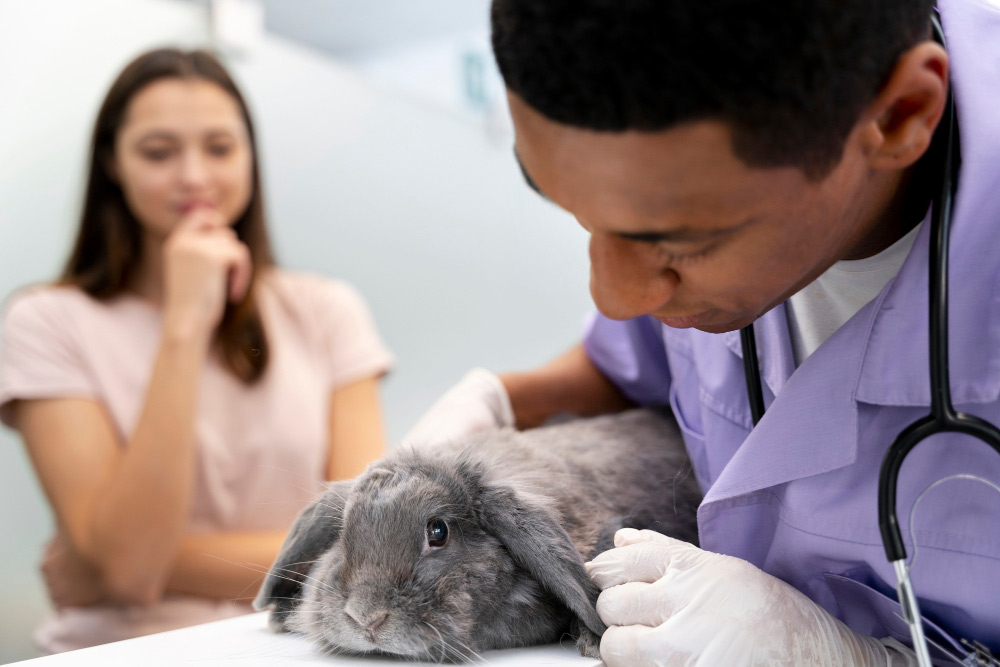
Hip Dysplasia is a developmental disease that begins with excessive laxity/looseness in the hip joints. This laxity causes progressive arthritis in the joints that leads to inflammation and pain. Symptoms associated with HD include bunny hopping, reluctance to jump up or go up the upstairs, and stiffness before or after activity. An obvious limp in a single rear leg is uncommon.
Diagnosis
Orthopedic exam abnormalities consistent with HD include a positive Ortolani sign, reduced range of motion in the hips with pain in extension and/or abduction, muscle atrophy and excessive leaning forward when rising from a sitting position. Radiographic abnormalities depend upon the severity and duration of the disease; laxity or arthritis in the hip joints support a diagnosis of HD. The severity of clinical disease often does not match the severity of radiographic disease.
Treatment
- Nonsurgical/Medical Management:
- Triple/Double Pelvic Osteotomy (TPO/DPO):
- Total Hip Replacement (THR):
- Femoral Head/Neck Ostectomy (FHO):
Nonsurgical management of HD generally incorporates weight loss if needed, use of a nonsteroidal anti-inflammatory drug (NSAID), use of an omega-3 fatty acid diet (e.g. Purina J/M or Hills J/D), pain medication (e.g. Amantadine) if needed and controlled activity (e.g. leash walks, swimming, cavalettis). Regardless of a patient’s treatment plan, medical management is incorporated into the long-term treatment plan to limit symptoms of arthritis. The are many alternative therapies (not approved or regulated by the FDA) that can be considered for the treatment of HD or other arthritic conditions. Examples include cetyl myristoleate, glucosamine products, chondroitin products, prolotherapy injections, biologics (e.g. platelet rich plasma, protein products, cell injections) and knee braces. Many factors influence outcome including age, breed, body weight and body condition score. Satisfactory pet function can be achieved ~60% of the time with medical management.
TPO includes a cut of the pubis, ischium and ilium. After these cuts the acetabulum (hip socket) can be moved; it is rotated and stabilized using a bone plate and screws so it better covers the femoral head (ball). The goals of TPO are to better cover the femoral head so the ball and socket joint rotate smoothly and to decrease the rate of progression of arthritis. In general, TPO is performed when nonsurgical management has ineffectively controlled hip pain, radiographic laxity is mild to moderate and radiographic arthritis is minimal. DPO is an acceptable, alternative procedure. Hip joint arthroscopy can be performed to better determine the health of the hip cartilage before performing TPO. After surgery, radiographs are performed to document the correct position of the osteotomies and implants. Potential complications after TPO include infection, loosening of implants and sciatic nerve paralysis (rare).
Postoperative care may include antibiotics, analgesics, visual inspection of the incision and exercise restriction (multiple 5-10 leash walks each day with limited access to stairs and jumping) for 4-6 weeks. 4-6 weeks after surgery recheck radiographs are performed to document bone healing. If it is healing well and TPO is recommended for the opposite side, surgery can be performed at this time. Following recheck radiographs a gradual return to normal activity is a common recommendation. Approximately 90-95% of dogs improve to near normal activity levels after TPO surgery. The cost for unilateral TPO is approximately $5500-6500. Bilateral, simultaneous TPO, or DPO, is a treatment option for dogs with signs of HD in both hips.
THR is performed when nonsurgical management has a guarded prognosis (hip luxation) or it has been ineffective (hip arthritis). THR includes replacement of the acetabulum and femoral head with implants. The acetabular implant usually has a metal back and polymer surface; the femoral implant is metal (e.g. cobalt-chromium alloy). Implants can be cemented or cementless (porous ingrowth) in place. It is wise to be familiar with both options so intraoperative options are not limited by surgeon experience. While THR is usually successful, complications (luxation, infection, fracture, aseptic loosening) can occur. When complications occur, it is often in the initial weeks after surgery. If a major complication occurs (surgery is necessary) a revision surgery that preserves the THR may be possible; alternatively, the implants can be removed and FHO can be performed.
Postoperative care may include antibiotics, analgesics, visual inspection of the incision and exercise restriction (multiple 5-10 minute leash walks each day with limited access to stairs, slippery floors and jumping) for 8 weeks. Recheck radiographs are often performed to document any changes in the hip joints 8-weeks after surgery. If THR is recommended for the opposite side, surgery is usually delayed until at least 4-months after surgery on the first side. Following recheck radiographs a gradual return to normal activity is a common recommendation. Approximately 90% of dogs improve to near normal activity levels after THR surgery. Cost is approximately $9-10,000.
FHO is a salvage procedure that should be performed when other treatment options have been exhausted. FHO is a treatment is a treatment option for hip dysplasia and for hip luxation (if closed or open reduction are ineffective), hip joint fracture (if fracture repair is not advised or unsuccessful) and Legg-Calves-Perthes disease. After FHO has been performed, future surgical treatment options are very limLted. FHO includes luxation of the hip joint (popping the femoral head out of the acetabulum) and removal of the femoral head and neck by cutting the bone from the greater trochanter to the lesser trochanter. This bone is discarded and the hip muscles and scar tissue that forms are left to support the joint.
After FHO, exercise restriction is recommended for ~2 weeks followed by a gradual return to normal activity. After 2-weeks, activity (walks, swimming, cavalettis) is generally encouraged so the hip muscles strengthen and scar tissue formation is not restrictive to hip motion. Cost is approximately $3000-4000.


